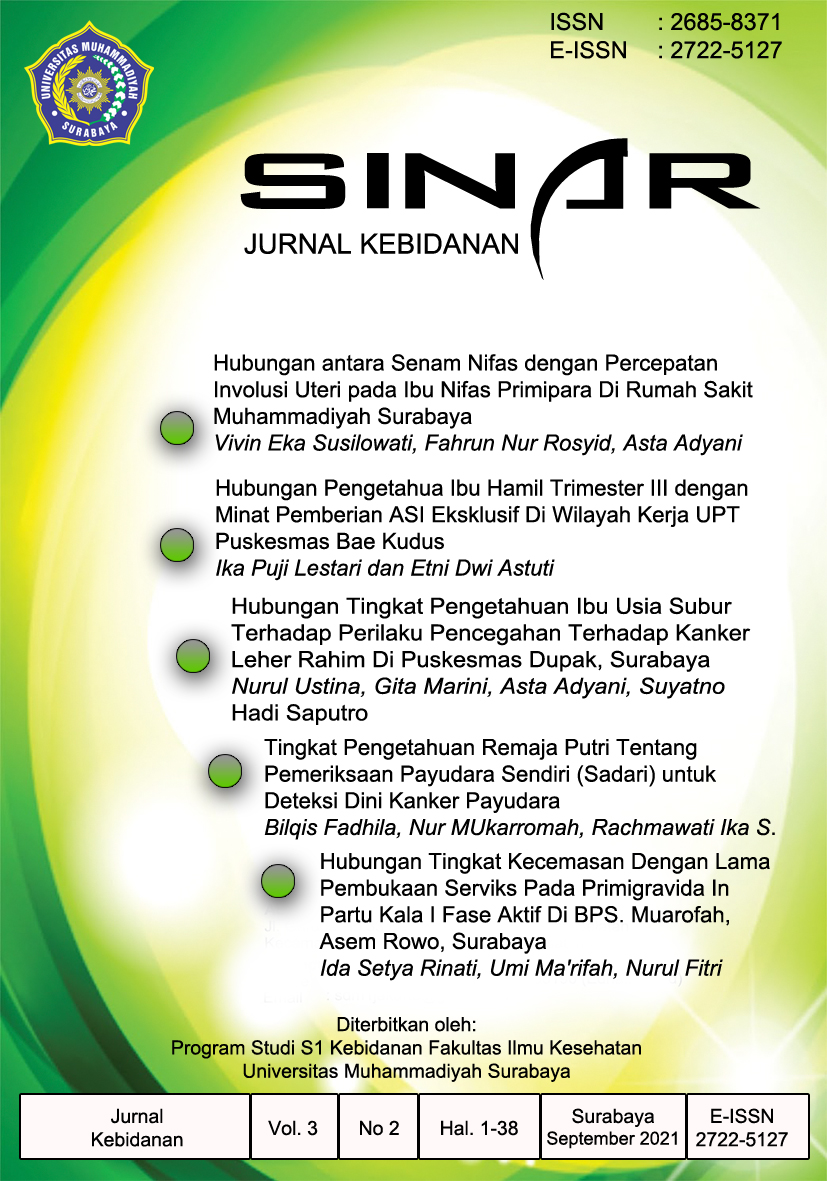Pengaruh Relaksasi dan Meditasi Terhadap Kecemasan Ibu Hamil Trimester III
Abstrak
Objective: To determine the effect of relaxation and meditation on the anxiety of third-trimester pregnant women.
Â
Methods: This study uses a quasy experimental design with pre-test and post-test. The sample used in this study comprised ten respondents through the total sampling technique. This research was conducted in October 2020. The research instrument used in this study used the Numerical Rating Scale (NRS) observation sheet, standard operating procedure (SOP) relaxation and standard operating procedure (SOP) meditation. The data obtained were then analysed using paired t-test and independent-test statistics to determine the effect of the two interventions on anxiety in third-trimester pregnant women.
Â
Results: Most mothers in the relaxation and meditation group were aged 26-35 years, namely seven people (70.0%) and eight people (80.00%). Based on parity, the number of primiparas and multiparas (50.00%) in the relaxation group was the same. Based on education, most mothers had secondary education in the relaxation group, namely five people (50.00%), and in the meditation group, there were eight people (80.00%). Based on occupation, most pregnant women did not work in the relaxation group, namely six people (60.00%). In the meditation group, the number was the same between working and non-working mothers (50.00%).
This study showed that the mean difference in the relaxation group was 14.4142, while the mean difference in the meditation group was 34.224, t = -5.316 and p=0.000. The mean difference in the meditation group was more significant than in the relaxation group and p=0.000.
Â
Conclusion: There is a significant difference in the effect of relaxation and meditation on anxiety levels in third-trimester pregnant women. Based on the results of this analytical test, meditation is more effective than relaxation in reducing anxiety levels in third-trimester pregnant women at RSI Darus Syifa', Surabaya.Artikel teks lengkap
Referensi
Bell, A., & Ross, K. (2014). The neuro psycho physiological effects of chronic and excessive stress. American International Journal of Social Science, 3(1), 199–213.
Chambers, A. S. (2007). Relaxation during pregnancy to reduce stress and anxiety and their associated complications. The University of Arizona.
Decker, J. T., Brown, J. L. C., Ashley, W., & Lipscomb, A. E. (2019). Mindfulness, meditation, and breathing exercises: reduced anxiety for clients and self-care for social work interns. Social Work with Groups, 42(4), 308–322.
Hamzah, H., Sugiharto, D. Y. P., & Tadjri, I. (2017). Efektifitas konseling kelompok dengan teknik relaksasi religius untuk mengurangi kejenuhan belajar mahasiswa. Jurnal Bimbingan Konseling, 6(1), 7–12.
Indirawaty, I., Rahman, R., Sumirah, B. P., & Khaerunnisa, K. (2018). STUDI KOMPARASI TERAPI KOMPLEMENTER YOGA DAN TERAPI MODALITAS AKTIVITAS KELOMPOK TERHADAP KEMAMPUAN MENGENDALIKAN HALUSINASI PENDENGARAN DI RUMAH SAKIT KHUSUS PROVINSI SULAWESI SELATAN. The Indonesian Journal of Health Science, 28–34.
Ismail, T. (2014). Pengaruh Pelatihan Relaksasi Terhadap Penurunan Tingkat Kecemasan Melahirkan Anak Pertama.
Kusaka, M., Matsuzaki, M., Shiraishi, M., & Haruna, M. (2016). Immediate stress reduction effects of yoga during pregnancy: One group pre–post-test. Women and Birth, 29(5), e82–e88.
Lovarini, M., & Wakely, A. (2007). At least 9 h of supervised relaxation training may reduce state anxiety and improve heart rate variability, prognosis and return to work for people with ischaemic heart disease. Australian Occupational Therapy Journal, 54(4), 315–316.
Mead, G. E., Greig, C. A., Cunningham, I., Lewis, S. J., Dinan, S., Saunders, D. H., Fitzsimons, C., & Young, A. (2007). Stroke: a randomized trial of exercise or relaxation. Journal of the American Geriatrics Society, 55(6), 892–899.
Penzien, D. B., Rains, J. C., & Andrasik, F. (2002). Behavioral management of recurrent headache: three decades of experience and empiricism. Applied Psychophysiology and Biofeedback, 27(2), 163–181.
Procelli, D. E. (2005). Effects of music therapy and relaxation prior to breastfeeding on the anxiety of new mothers and the behavior state of their infants during feeding.
Purwaningsih, H. (2020). Analisis masalah psikologis pada ibu hamil selama masa pandemi covid-19: literature review. Call for Paper Seminar Nasional Kebidanan, 1(1), 9–15.
Ravinder, J., Barnes, V. A., & Crawford, M. W. (2014). Mind-body response and neurophysiological changes during stress and meditation: central role of homeostasis. Journal of Biological Regulators and Homeostatic Agents, 28(4).
Retnowati, S. (2011). Pengaruh pelatihan relaksasi dengan dzikir untuk mengatasi kecemasan ibu hamil pertama. Psikoislamika: Jurnal Psikologi Dan Psikologi Islam, 8(1).
Saisto, T., Toivanen, R., Salmela-Aro, K., & Halmesmäki, E. (2006). Therapeutic group psychoeducation and relaxation in treating fear of childbirth. Acta Obstetricia et Gynecologica Scandinavica, 85(11), 1315–1319.
Salafas, E., Anisa, R., & Rusita, V. I. (2016). Efektifitas Hypno-EFT dan Pernafasan Yoga dalam Menurunkan Kecemasan Ibu Hamil di BPM Ny. Sri Kustinah. Bidan Prada, 7(2).
Suristyawati, P., Yuliari, S. A. M., & Suta, I. B. P. (2019a). Meditasi Untuk Mengatasi Kecemasan Pada Ibu Hamil. Widya Kesehatan, 1(2), 20–27.
Suristyawati, P., Yuliari, S. A. M., & Suta, I. B. P. (2019b). Meditasi Untuk Mengatasi Kecemasan Pada Ibu Hamil. Widya Kesehatan, 1(2), 20–27.
Teixeira, J., Martin, D., Prendiville, O., & Glover, V. (2005). The effects of acute relaxation on indices of anxiety during pregnancy. Journal of Psychosomatic Obstetrics & Gynecology, 26(4), 271–276.
Vocks, S., Ockenfels, M., Jürgensen, R., Mussgay, L., & Rüddel, H. (2004). Blood pressure reactivity can be reduced by a cognitive behavioral stress management program. International Journal of Behavioral Medicine, 11(2), 63–70.
Yu, C.-M., Zhang, Q., Lam, L., Lin, H., Kong, S.-L., Chan, W., Fung, J. W.-H., Cheng, K. K. K., Chan, I. H.-S., & Lee, S. W.-L. (2007). Comparison of intensive and low-dose atorvastatin therapy in the reduction of carotid intimal–medial thickness in patients with coronary heart disease. Heart, 93(8), 933–939.
Penulis
Hak Cipta ada di penulis, jurnal ini berada di bawah Lisensi
https://creativecommons.org/licenses/by-nc/4.0/


